Table of contents
- Comparison test all-rounder, Suzuki Bandit 650 Fun society
- Technical data: Honda CBF 600 S
- Technical data: Kawasaki ER-6f
- Technical data: Suzuki Bandit 650 S
- Technical data: Suzuki SV 650 S
- Performance chart
- Scoring: engine
- Scoring: chassis
- Scoring: Security
- Scoring: everyday life
- Scoring: comfort
- Scoring: costs / environment
- 1st place – Kawasaki ER-6f
- 2nd place – Honda CBF 600 S
- 3rd place – Suzuki Bandit 650 S
- 4th place – Suzuki SV 650 S
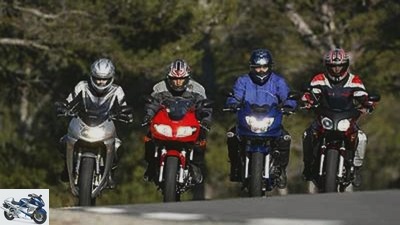
Artist
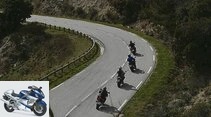
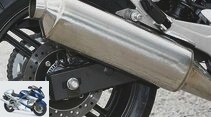
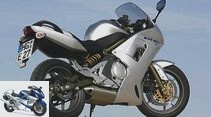

48 pictures
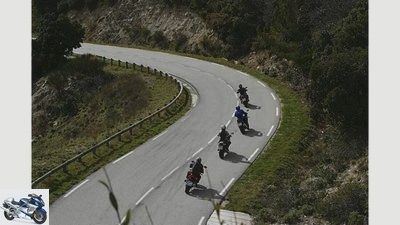
Artist
1/48
Four inexpensive motorcycles have appeared in the south of France …
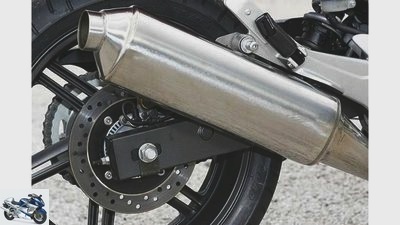
Artist
2/48
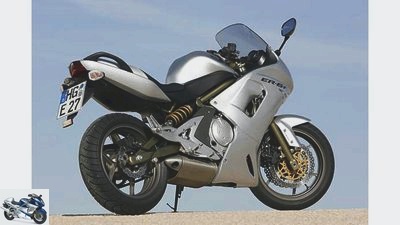
Artist
3/48
The winner of the 1000-point evaluation drives easily and exhilarated.
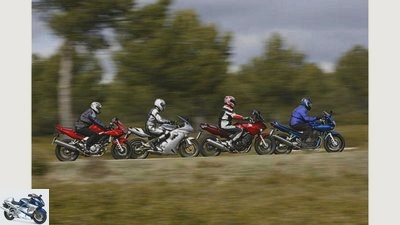
Artist
4/48
The lady in blue is next:
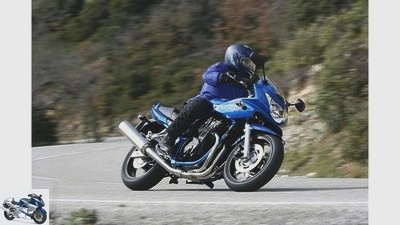
Artist
5/48
The fork that is too soft costs a few points.
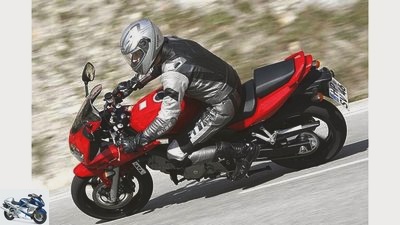
Artist
6/48
… an ABS to test victory. Unfortunately, this is not available.
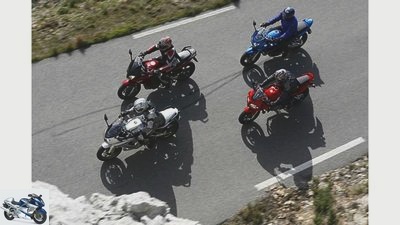
Artist
7/48
… measure their strengths and weaknesses.
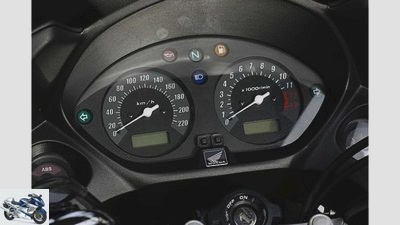
Artist
8/48
The analog instruments are clearly arranged. In the displays: odometer and clock.
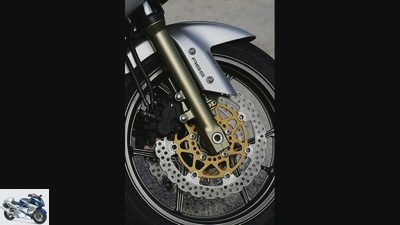
Artist
9/48
If you hit the brakes hard, you run the risk of stoppies because the electronic helper intervenes quite late.
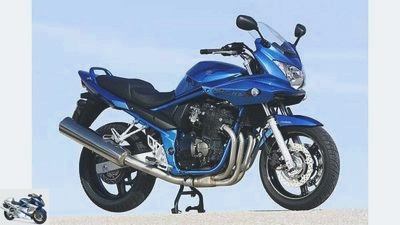
Artist
10/48
The Suzuki Bandit 650 S.

Artist
11/48
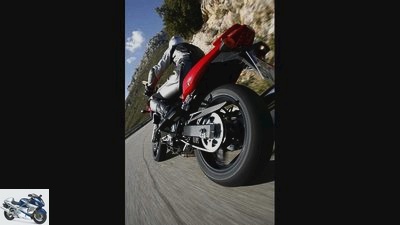
Artist
12/48
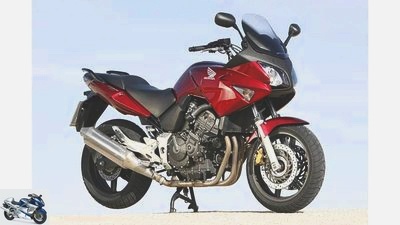
Artist
13/48
Candidate number one: The Honda CBF 600 S.
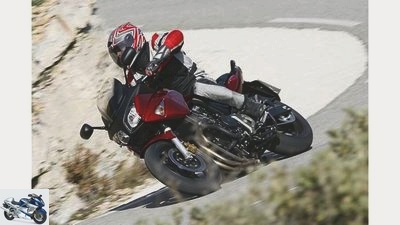
Artist
14/48
Fast on the road even on the worst roads, …
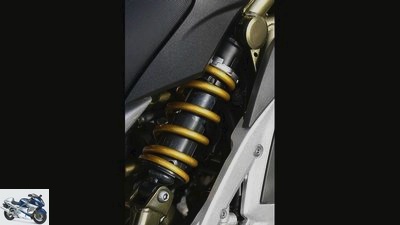
Artist
15/48
Comfortable, agile, handy … unfortunately fixed.
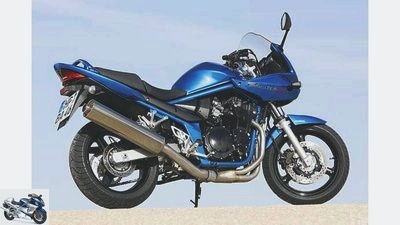
Artist
16/48
In the 1000-point evaluation, she was also able to get on the podium.
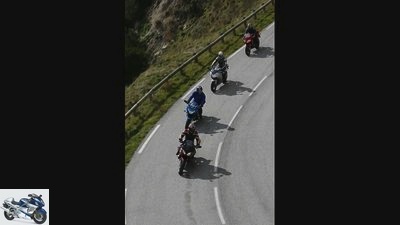
Artist
17/48
Next motorcycle tested:
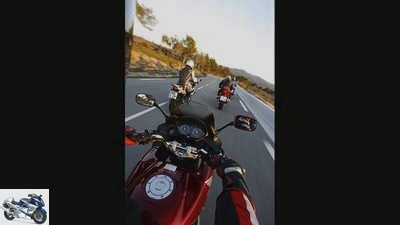
Artist
18/48
In summary, one can say that, even if the ER-6f won the rating, …
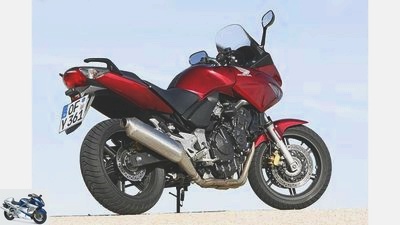
Artist
19/48
A decent motorcycle for a decent price.

Artist
20/48
… The CBF trumps with a balanced and easily manageable chassis.

Artist
21/48
Large analog instruments adorn the cockpit.
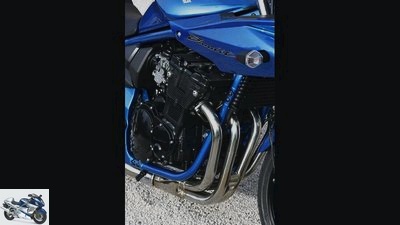
Artist
22/48
The sprinting, high-torque engine is fun.
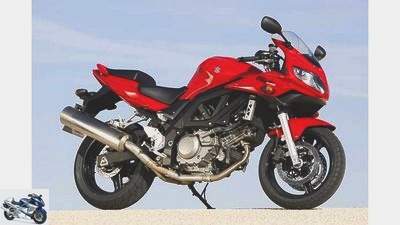
Artist
23/48
The Suzuki SV 650 S

Artist
24/48
… all tested motorcycles were very close together. One better here, the other there.
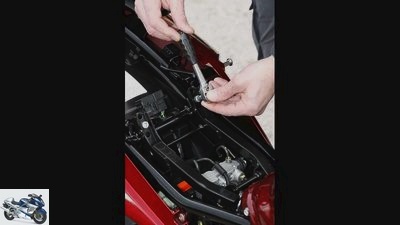
Artist
25/48
Elaborate: You need tools for the cumbersome seat height adjustment.
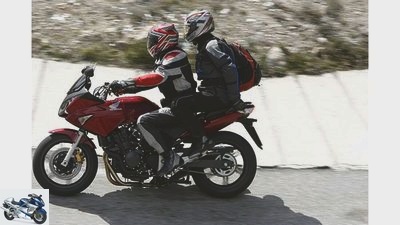
Artist
26/48
The relatively low payload quickly pushes the Honda to its limits in pillion mode.
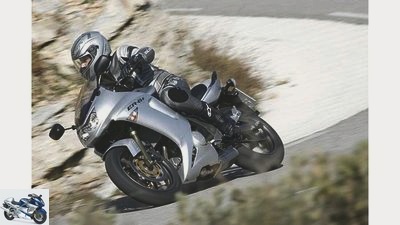
Artist
27/48
Playful, easy handling.
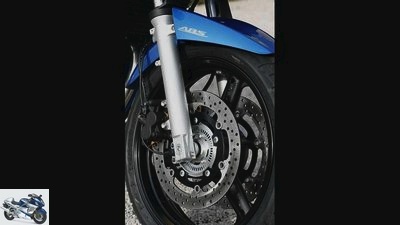
Artist
28/48
Not easy to dose: the disc brakes require a strong hand.
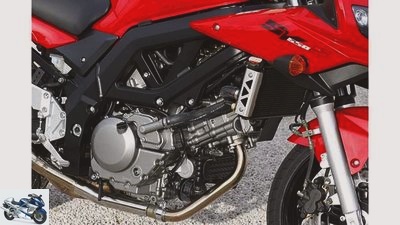
Artist
29/48
Could win the engine rating: the engine.
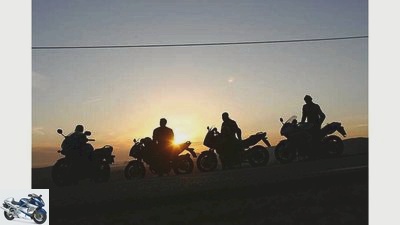
Artist
30/48
What a day!
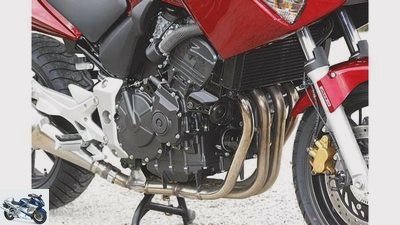
Artist
31/48
A little weak in terms of torque. The four-cylinder carburetor engine from CBF.
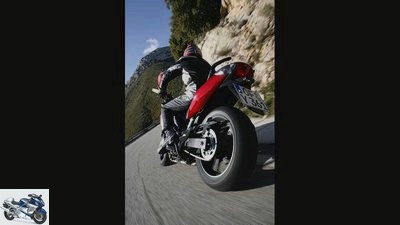
Artist
32/48
The CBF is a lot of fun.
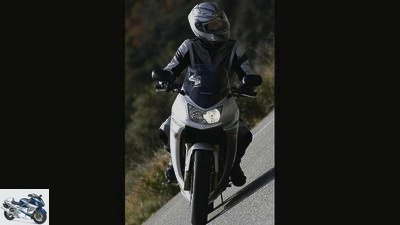
Artist
33/48
The Kawa sipped a remarkable 4.6 liters of fuel.
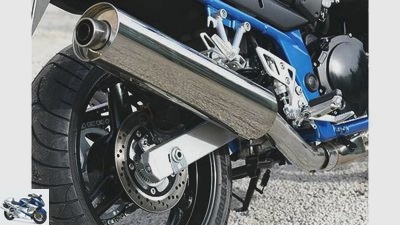
Artist
34/48
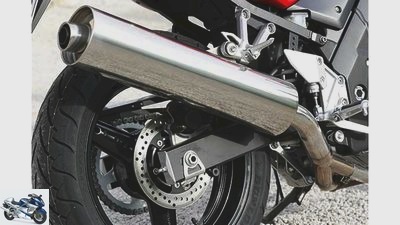
Artist
35/48
The rear silencer looks a little disproportionate.
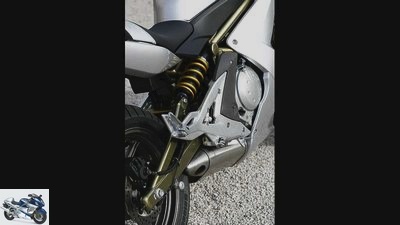
Artist
36/48
Installed hidden: the silencer is located between the swing arm, tires and fairing.
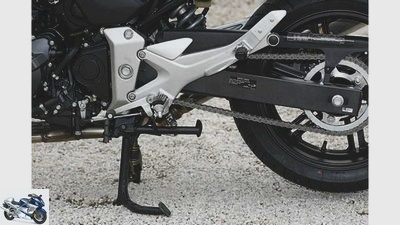
Artist
37/48
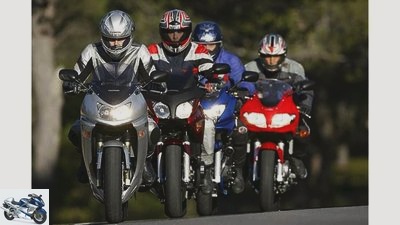
Artist
38/48
Next up in the test …
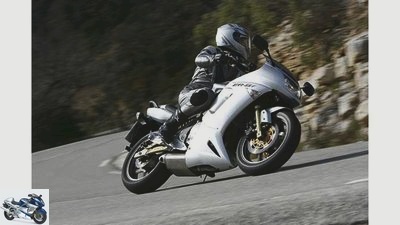
Artist
39/48
Not much is missing for an athlete …
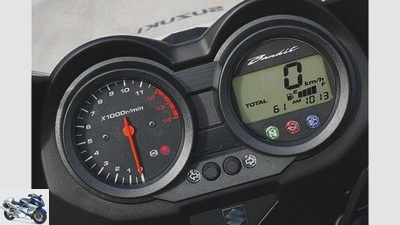
Artist
40/48
Looks a little improvised, the rectangular digital instrument in the round case.

Artist
41/48
Unconventional arrangement in the tapered cockpit.
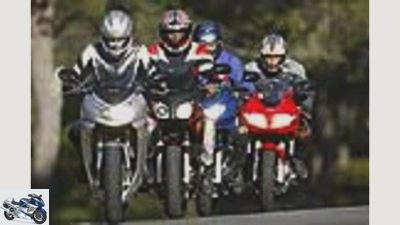
42/48
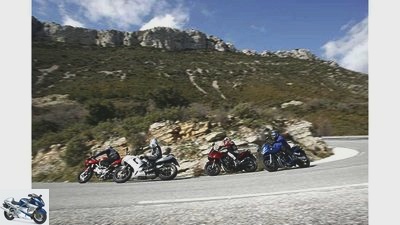
Artist
43/48
Fun company: The Honda CBF 600 S, Kawasaki ER-6f, Suzuki’s Bandit 650 S and SV 650 S took part in the all-rounder comparison test.
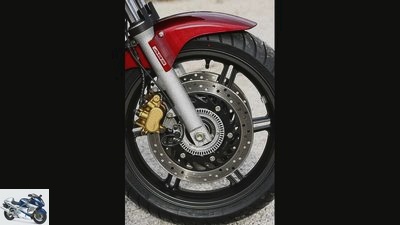
Artist
44/48
Too fast? The brakes with extra-chargeable ABS decelerate perfectly.
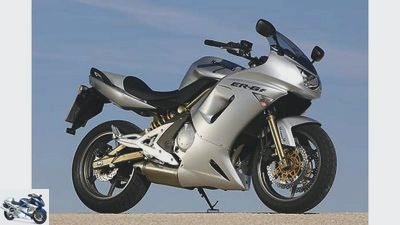
Artist
45/48
… the Kawasaki ER-6f.
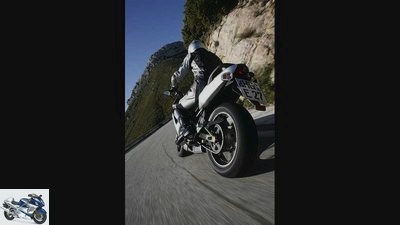
Artist
46/48
… Nevertheless, you sit casually relaxed on the ER-6f.
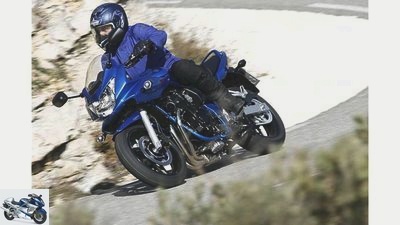
Artist
47/48
Everyone is in good hands on the comfortable Bandit.
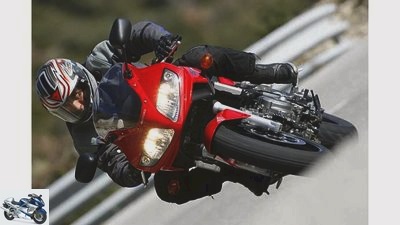
Artist
48/48
The all-rounder lacks a comfortable seating position …
motorcycles
Comparison test all-rounder
Comparison test all-rounder, Suzuki Bandit 650
Fun society
Accelerate without hesitation, enjoy easy curve combinations, playfully easy and lively. What a day!
Norbert Kappes
03/14/2006
Crazy world. Sometimes rain actually makes for ideal conditions for motorcycling. Over night, heavy showers washed away gravel and salt crusts, which turned the asphalt surface into a treacherous slide, and the surface is grippy again. In addition a cloud-
loose sky, and sun and wind blow dry the asphalt strip in a short time. Perfect. Sounds more hectic from the mountains
Four-cylinder sound. Aisles are loaded through. Up and down, as the course of the road allows. Two-cylinder sounds hold against it with a dull rumble. The mountain is alive. Spring is coming. At least in Provence.
Four inexpensive motorcycles with more or less tight fairings have appeared to open the two-wheeler season with a winding ride in the south of France. First the four-cylinder Honda CBF 600 S, equipped with a feel-good package made of ABS (for an extra charge), two-way height-adjustable disc, three different ones
Positions for seat and handlebars, as well as a main stand. It is included in the ABS surcharge. That makes a total of 7,310 euros for the 78 hp CBF. The Suzuki also has four cylinders and is equally powerful Bandit 650 S on. Even with her
the seat height is variable, but there are
there are only two alternatives. The handlebar can be adjusted in height by the length of a spacer sleeve. Both are associated with effort. A main stand facilitates maintenance work. An anti-lock braking system is included in the price of 6920 euros.
With two fewer cylinders, the new, fully encased one joins Kawasaki ER-6f added. Injection and regulated kata-
lysator make sure that you are the only one
in this quartet already met the Euro 3 standard. The 72 hp Kawa can also be used for an additional charge of 600 euros
can be ordered with ABS. Total cost: 7,365 euros.
After all, it makes 1000 euros more than
for the Suzuki SV 650 S. The sporty-looking V-twin-cylinder with injection is available for an attractive 6300 euros after a price reduction. And like the Kawa’s in-line twin, it offers a nominal 72 hp. However, the SV does not use ABS, which is not even available for a surcharge.
Despite the diverse ergonomic variants of the Honda CBF 600, one possibility emerges as that for all drivers-
The handlebars are positioned far forward to optimize the feel of the front wheel, and the top position of the bench is enough for even smaller people to reach the ground safely when maneuvering and at the same time ensure a relaxed knee angle when driving.
But before the load rolls, it must first be started. And patience is required. It takes a long time with the choke on the carburetor battery before the
Four-cylinder takes gas without any symptoms. After that, however, it purrs as velvety as a kitten, willingly takes on the gas and spoils you with a straightforward performance characteristic. Bouncing around at low speed in sixth gear, starting at medium speeds for a short overtaking maneuver or quickly using the six gears
Stepping up and down to get the last bit of power in sporting use – the easy-revving CBF engine seems to allow all gaits. The measured driving performance is only mediocre, however. In the through-
In fact, CBF is lagging quite behind its counterparts, losing around by
60 to 100 km / h significantly more than one
Second. In order to stay tuned, the Honda has to be kept up to speed. That costs fuel. At least compared to the two-cylinder engines, the CBF consumes significantly more, namely 5.7 liters at a moderate country road speed.
But right here, where curves line up seamlessly and road builders have not rolled everything flat, comes
the CBF on their big appearance. As if it were the easiest thing in the world to take
they are easy to control, casual and goal-oriented-
sure any combination of curves under the wheels, meanders inconspicuously and swiftly through. Even without adjustment options, the well-coordinated spring elements ensure a successful compromise between pleasant comfort and precise road feedback. So the Honda is safe and fast even on bad roads. The easy-to-dose and, if necessary, hard-hitting disc brakes also contribute to stress-free driving behavior. Too fast? No problem. Even in an inclined position, the Honda brakes without a strong righting moment. And the sensitive ABS helps after major driving errors.
The four-cylinder alternative to the Honda is called the Suzuki Bandit 650 S. Its extra displacement of 56 cubic centimeters compared to the Honda has a clearly noticeable effect despite nominally the same performance. On the one hand, the Bandit has to turn far less high to exhaust its full power, on the other hand, it develops noticeably more torque over the entire usable speed range. Even at low speeds, your engine leans into power
Dishes to spray with vitality between 6000 and 8000 / min, although it is still far from its performance zenith
has reached. But it doesn’t really need high speeds to drive the bandit briskly across the country. The four-cylinder, charged with energy, pulls out of the curve and hangs
neatly matched on the cable. And when there’s a fire, just briefly downshift one or two gears, and Suzi puts a considerable sprint on the floor. Neither
The Honda can hold a candle to it in acceleration while still pulling through. The Bandit only does the same as the CBF when it comes to cold starts and consumption. Reluctantly and with the choke pulled, she accelerates for the first few meters, and with 5.6
Liters the fuel consumption levels off at Honda level.
The sitting position on the Bandit is relaxed and upright. Wouldn’t be there
the handlebar ends, which are cranked a little too far back, would make you sit as comfortably relaxed as on the Honda. What nothing
mind that also changes the bandit on
Immediately conveyed a high level of trust. With not so little effort, it follows alternating curves or can be thrown briskly in an inclined position. The telescopic fork, however, could use harder fork springs so that it doesn’t reach its limits so quickly, especially on undulating slopes and when walking at a sporty pace. The Bandit is still not lacking in stability, and its good-natured driving is convincing even at the limit-
behave. The good decelerating brake
however, it is not easy to dose. Not only,
that the front disc brakes require a firm handshake. The ABS also seems to be in the normal range
in rare situations the pressure point in
to block a position.
Get off the four-cylinder, up on the two-cylinder Kawasaki ER-6f. Oops – when you switch, you think you’ve landed on a bike. The ER-6f is graceful with its full fairing, the knee joint tight, the seat cushion tight, and the narrow handlebars to match. To characterize you as an athlete for this reason would be an exaggeration, however. Finally allowed
she the driver, a casually relaxed
Take a stand If necessary, you could drive to the end of the world in this way.
This perceived lightness, being at one with the motorcycle, the handiness with which it reacts to steering movements, all of this is reflected in a pleasant way in the playful handling of the ER-6f. In addition, the powerful pulse of the twin warms every motorcyclist’s heart. Thanks to the injection, clean power is available at the push of a button. Cold start problems? Load change reactions? Almost no issue. But be careful – the Kawa picks up the chain from the low revs. 4000 tours have to be under load so that the roaring two-cylinder can initially develop its power gently, only to tug vigorously, sometimes vigorously, at the drive train a little later without interruption to just over 9000 rpm. So it is not surprising that the ER-6f, although geared to 210 km / h as long as the Honda, sets the scene with decent pulling values. What also works out well: the low consumption. The economical ER-6f only consumes 4.6 liters, which is why, despite the smallest tank volume in the test quartet (15.5 liters), it does not lag behind the others with a range of well over 300 kilometers.
The comfortably coordinated, but not adjustable, spring elements fit in with this. Small downer: the directly linked, barely progressive spring leg is rather weakly dampened and seduced
the otherwise accurate and stable ER-6f on undulating ground for easy pumps-
movements. The ABS, which is subject to a surcharge, cannot convince in all respects either. Those who push hard sometimes involuntarily risk stoppies before the system, which is otherwise good regulating behavior, kicks in.
So far it has been quite comfortable, sometimes even contemplative, as far as the ergonomics of the CBF, ER-6f and Bandit 650 are concerned. Anyone interested in the half-faired Suzuki SV 650 S should be sporty and reasonably trained. At the very least, you need strong forearms and strong neck muscles in the long run to support yourself on the handlebar stumps and, with your head back, to keep an overview.
Up the footrests, down with the upper body, the SV 650 S is all about sports. Strolling through the city or taking leisurely overland tours are clearly at the expense of your stamina. The driving posture only makes sense when driving briskly. The stretched SV requires an active driving style. This is the only way to allow rough cornering radii, which are reinforced by the spontaneous throttle response. Tight hairpin bends can also be tricky in other ways, namely when the agility of the SV turns nervous and wobbly from a certain incline.
With a tight chassis set-up, direct contact with the road, reliable feedback and precisely responsive, powerful brakes, on the other hand, sporty rides are pure pleasure. temperament-
the beefy, high-torque 90-degree V-twin-cylinder makes its power available at any time. Only 72 hp? It is hard to believe. Indeed, the MOTORRAD performance measurement proves that there is a few more horsepower in it.
Impeccable cold start behavior and low fuel consumption are further virtues of the SV 650 S. Nevertheless, it comes last in the very tight fight for the best place. If they could offer a safety-relevant ABS, a few more buyers would certainly be on their side again.
Buy complete article
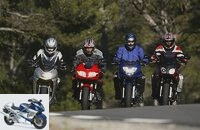
Comparison test all-rounder
Fun society
14 pages) as PDF
€ 2.00
Buy now
Technical data: Honda CBF 600 S
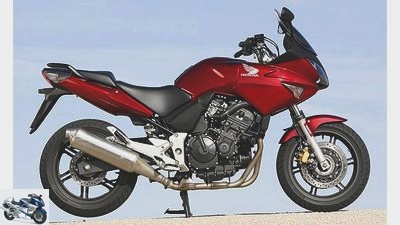
Engine: water-cooled four-cylinder four-stroke in-line engine, two overhead, chain-driven camshafts, four valves per cylinder, bucket tappets, wet sump lubrication, constant pressure carburetor, Ø 34 mm, uncontrolled catalytic converter with secondary air system, alternator 336 W, battery 12 V / 6 Ah, mechanically operated multiple discs – Oil bath clutch, six-speed gearbox, chain.
Bore x stroke 65.0 x 45.2 mm
Displacement 600 cm3
Compression ratio 11.6: 1
Rated output 57.0 kW (78 hp) at 10500 rpm
Max. Torque 58 Nm at 8000 rpm
Pollutant values (homologation) in g / km
CO 2.624 / HC 0.773 / NOx 0.109
Chassis: Bridge frame made of steel, telescopic fork, Ø 41 mm, two-arm swing arm made of steel, central spring strut, directly hinged, adjustable spring base, double disc brake at the front, Ø 296 mm, double-piston floating calipers, disc brake at the rear, Ø 240 mm, single-piston floating caliper.
Cast aluminum wheels 3.50 x 17; 4.50 x 17
Tires 120/70 ZR 17; 160/60 ZR 17
Tires in the Michelin Pilot Road test, front “B”
Dimensions and weights: wheelbase 1480 mm, steering head angle 64.0 degrees, caster 109 mm, spring travel f / h 120 /
128 mm, seat height * 770–800 mm, weight with a full tank * 229 kg, payload * 175 kg, tank capacity 19.0 liters.
Warranty two years
Service intervals every 6000 km
Colors blue, red, black, silver
Power variant 25 kW (34 PS)
Price 6540 euros
Price test motorcycle1 7,140 euros
Additional costs 170 euros
Technical data: Kawasaki ER-6f

Engine: water-cooled two-cylinder four-stroke in-line engine, a balance shaft, two overhead, chain-driven camshafts, four valves per cylinder, Ga-
rocker arm, dry sump lubrication, injection, Ø 38 mm, regulated catalytic converter, alternator 336 W, battery 12 V / 14 Ah, mechanically operated multiple discs-
Oil bath clutch, six-speed gearbox, O-ring chain.
Bore x stroke 83.0 x 60.0 mm
Cubic capacity 649 cm3
Compression ratio 11.2: 1
Rated output 53.0 kW (72 hp) at 8500 rpm
Max. Torque 66 Nm at 7000 rpm
Pollutant values (homologation) in g / km
CO 1.044 / HC 0.170 / NOx 0.052
Chassis: tubular steel frame, telescopic fork, Ø 41 mm, two-arm swing arm made of steel, central spring strut, directly hinged, adjustable spring base, double disc brake at the front, Ø 300 mm, double-piston floating calipers, disc brake at the rear, Ø 220 mm, single-piston floating caliper
Cast aluminum wheels 3.50 x 17; 4.50 x 17
Tires 120/70 ZR 17; 160/60 ZR 17
Tires in the test Bridgestone BT 020, front »GG«
Dimensions and weights: wheelbase 1410 mm, steering head angle 65.0 degrees, caster 106 mm, spring travel f / h 120 /
125 mm, seat height * 795 mm, weight with a full tank * 204 kg, payload * 180 kg, tank capacity 15.5 liters.
Warranty two years
Service intervals every 6000 km
Colors silver, black
Power variant 25 kW (34 PS)
Price 6595 euros
Price test motorcycle2 7,195 euros
Additional costs 170 euros
Technical data: Suzuki Bandit 650 S
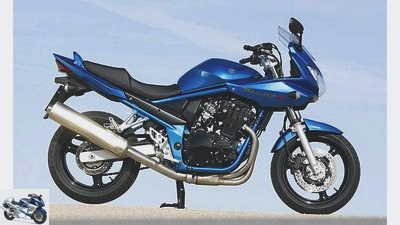
Engine: air / oil-cooled four-cylinder four-stroke in-line engine, two overhead, chain-driven camshafts, four valves, fork rocker arms, wet sump lubrication, constant pressure carburetor, Ø 32 mm, uncontrolled Kata-
Analyzer with secondary air system, 475 W alternator, 12 V / 8 Ah battery, mechanically operated multi-disc oil bath clutch, six-speed gearbox, O-ring chain.
Bore x stroke 65.5 x 48.7 mm
Cubic capacity 656 cm3
Compression ratio 10.5: 1
Rated output 57.0 kW (78 hp) at 10,100 rpm
Max. Torque 59 Nm at 7800 rpm
Pollutant values (homologation) in g / km
CO 1.920 / HC 0.580 / NOx 0.150
Chassis: double loop frame made of steel, telescopic fork Ø 41 mm, adjustable spring base, two-arm swing arm made of steel, central spring strut with lever system, adjustable spring base and rebound damping, double disc brake at the front, Ø 290 mm, double-piston floating calipers, disc brake at the rear, Ø 240 mm, two-piston fixed caliper , SECTION.
Cast aluminum wheels 3.50 x 17; 4.50 x 17
Tires 120/70 ZR 17; 160/60 ZR 17
Tires in the test Bridgestone BT 011 »J«; BT 020 “L”
Dimensions and weights: wheelbase 1440 mm, steering head angle 64.0 degrees, caster 108 mm, spring travel f / h 130/126 mm, seat height * 775–795 mm, weight with a full tank * 228 kg, payload * 212 kg, tank capacity 20.0 liters.
Warranty two years
Service intervals every 6000 km
Colors blue, black, gray, red
Power variant 25 KW (34 PS)
Price 6790 euros
Additional costs 130 euros
Technical data: Suzuki SV 650 S
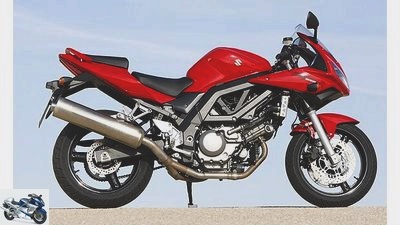
Engine: water-cooled two-cylinder four-stroke 90-degree V-engine, two overhead, chain-driven camshafts, four valves per cylinder, bucket tappets, wet sump lubrication, injection, Ø 39 mm, uncontrolled Kata-
Analyzer with secondary air system, 375 W alternator, 12 V / 10 Ah battery, mechanically operated multi-disc oil bath clutch, six-speed gearbox, O-ring chain.
Bore x stroke 81.0 x 62.6 mm
Cubic capacity 645 cm3
Compression ratio 11.5: 1
Rated output 53.0 kW (72 hp) at 9000 rpm
Max. Torque 64 Nm at 7200 rpm
Pollutant values (homologation) in g / km
CO 2.005 / HC 0.440 / NOx 0.108
Chassis: Bridge frame made of aluminum, telescopic fork, Ø 41 mm, adjustable spring base, two-arm swing arm made of aluminum, central spring strut with lever system, adjustable-
bare spring base, double disc brake at the front, Ø 290 mm, double-piston floating calipers, disc brake at the rear,
Ø 220 mm, single-piston floating caliper.
Cast aluminum wheels 3.50 x 17; 4.50 x 17
Tires 120/60 ZR 17; 160/60 ZR 17
Tires in the test Dunlop D 220 ST, “L”
Dimensions and weights: wheelbase 1430 mm, steering head angle 65.0 degrees, caster 100 mm, spring travel f / h 130 /
137 mm, seat height 820 mm, weight with a full tank * 196 kg, payload * 204 kg, tank capacity 17.0 liters.
Warranty two years
Service intervals every 6000 km
Colors blue, gray, red, silver
Price 6160 euros
Additional costs 140 euros
Performance chart
Both Suzuki engines stand well in the forage. In particular, the SV lies
with five additional horsepower, well above the official power rating.
To do this, it draws a torque curve, behind which those of the
Competitors seem to fade away. No wonder that the V-twin-cylinder is so thrilling when driving. Turn out to be less strong on the test bench
Honda and Kawasaki. Nevertheless, the latter can still be
swing up to remarkably good driving performance.
Scoring: engine
the four-cylinder the bandit can
clearly put the competitors in their place in the mileage ratings. Even the powerful two-cylinder engines, which are unbeatable in terms of power delivery, can hardly keep up. Weak the appearance of the revving Honda. Your acceleration is only mediocre and lazy driving-
wise not recommended due to lack of draft. In addition, its carburettor engine, like that of the Bandit, has a poor cold start-
properties. The injected master this exercise
Two-cylinder almost perfect. Only the Kawa sometimes dies shortly after starting.
Scoring: chassis
Who is as agile as it is handy
The ER-6f won’t let go of the chassis that quickly. However, the spring elements of the test machine seemed a bit slacker than on earlier models, which leads to deductions. Balance and easy controllability are virtues of the CBF 600. From a sporting point of view, the SV 650 chassis works to full satisfaction. In contrast, the bandit fork, which is too soft, needs improvement.
Scoring: Security
A rough climate for the SV 650 S: If you don’t have ABS, you get nothing. But those who do not rule out pitfalls in the ABS regulation are also not allowed to overly lavish points-
calculation, as demonstrated by the ER-6f with its rear wheel lifting off the ground. High operating forces and moderate controllability with the Bandit or with the SV 650 the noticeable righting moment when braking in an inclined position are more likely to be the case
minor weaknesses. The ER-6f and the sporty SV 650 S. Note on the side: More consideration in the
For the Kawa, road traffic would mean installing larger mirrors.
Scoring: everyday life
It’s great that Honda and Suzuki have recognized how differently tall people have grown. This is why ergonomic packages (CBF, Bandit) are included in the equipment criterion
honored. What remains incomprehensible, however, is how little consideration is given to people who like to be out and about in pairs. Low payloads quickly push the CBF and ER-6f to their limits.
Scoring: comfort
Sitting on the Honda means pure wellbeing. But ER-6f and Bandit also provide comfortable seats, also for the
Passenger, ready. Due to its sporting orientation, the SV comes off worst here. Where the passenger is in first
Line will complain about the angular headband. Mentioning-
The height-adjustable windshield on the CBF is still worth it.
Scoring: costs / environment
The Kawasaki collects a lot of points at the
Consumption and exhaust gas values. Your modern drive is not only reluctant to handle fuel. With a regulated catalytic converter, the engine already complies with the strict Euro 3 emissions regulations. A few euros can be saved in the inspection costs if you opt for the CBF 600 or
ER-6f decides.
1st place – Kawasaki ER-6f
KAWASAKI ER-6f your life-
diger and powerful two-cylinder
is a stunner. Always light and lively
declares the Er-6f highways to be their territory. With better tuned ABS, a few more points would have been possible.
2nd place – Honda CBF 600 S
HONDA CBF 600 S It offers an ergonomics package, a foolproof ABS with impeccable brakes, an easily controllable, well-engineered chassis and decent engine performance. All for a reasonable price. A better engine is missing to win.
3rd place – Suzuki Bandit 650 S
Suzuki Bandit 650 S Everyone is good on the comfortable Bandit
canceled. The sprinting, high-torque engine is fun. Too soft
The fork and the brake, which demands a strong hand, cost a few points.
4th place – Suzuki SV 650 S
Suzuki SV 650 S For
All-rounder, she lacks a more comfortable seating position, and only one ABS to win the test.
But those who pursue sporting ambitions have to resort to the SV and get a powerful engine and an agile chassis.
Related articles
-
fact motorcycles Middle class comparison test Middle class comparison test Just turn blue The sun is shining, the early autumn beckons: away with pencil…
-
Comparison test Honda CBF 1000 against Suzuki Bandit 1250 S
Rossen Gargolov motorcycles Comparison test Honda CBF 1000 against Suzuki Bandit 1250 S Comparison test Honda CBF 1000 against Suzuki Bandit 1250 S We…
-
Gargolov motorcycles Comparison test: big bikes Comparison test: Big Bikes from Honda and Suzuki Test: Honda CBF 1000 F, CB 1300 S and Suzuki Bandit 1250…
-
Comparative test of the mid-range all-rounder
fact 15th pictures 1/15 2/15 3/15 4/15 5/15 6/15 7/15 8/15 9/15 10/15 11/15 12/15 13/15 14/15 15/15 motorcycles Comparative test of the mid-range…
-
Comparison test: Honda Hornet, Kawasaki Z 750, Suzuki GSR 600
Jahn motorcycles Comparison test: Honda Hornet, Kawasaki Z 750, Suzuki GSR 600 Comparison test: Honda Hornet, Kawasaki Z 750, Suzuki GSR 600 ABS shooters…
-
Comparison test: Honda CBF 1000 Silverline, Suzuki Bandit 1250 S, Yamaha FZ1 Fazer
Jahn 22nd pictures Honda 1/22 Honda CBF 1000 Honda 2/22 Honda CBF 1000 Zdrahal 3/22 Presentation at the fair in Paris. Honda 4/22 Honda CBF 1000 Honda…
-
Honda CBR 300 R and Honda CBR 500 R in comparison test
Gargolov 33 pictures Rossen Gargolov 1/33 Two against one is not fair? We see how the single-cylinder Honda CBR 300 R fares against the two-cylinder…
-
Comparison test: Japanese naked bikes
Jahn motorcycles Comparison test: Japanese naked bikes Comparison test: Japanese naked bikes Go big Content of …or go home! Big bore instead of boring,…
-
Comparison test: Honda CBF 600 S and Kawasaki ER-6f
Gargolov motorcycles Comparison test: Honda CBF 600 S and Kawasaki ER-6f Comparison test Honda CBF 600 S and Kawasaki ER-6f They don’t shine in the…
-
Comparison test Honda CBF 125 against Yamaha YBR 125
fact motorcycles Comparison test Honda CBF 125 against Yamaha YBR 125 Comparison test Honda CBF 125 against Yamaha YBR 125 Inexpensive 125cc singles No…